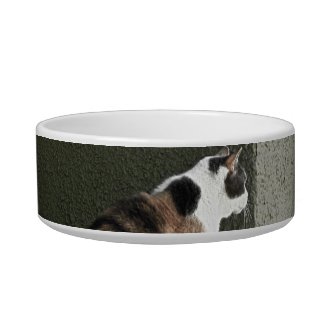
Wednesday, February 29, 2012
Back to Drawings
After weeks, or perhaps months house cleaning, finally, I reclaimed by drawing table from piles and piles items, useful or useless and last night, I really sat down and worked on drawing again. It felt good to be able to work on those media again:


Labels:
Boy,
My Drawing,
Semi-Nude
Tuesday, February 28, 2012
My Favorite Artworks in San Pietro in Vincoli (Saint Peter in Chains), Roma
The last Roman institution in the list of those I visited in 2000 is another church - San Pietro in Vincoli, or Saint Peter in Chains. The main draw there were the relic of the chains that bound Saint Peter when he was imprisoned in Jerusalem - the true chains. It was a delicate thing in the Reliquary. It had historical or fantastical values, depending your value on its authenticity.
For the indisputable artistic masterpiece, there was Michelangelo Buonarroti's marble sculpture Moses, the centerpiece of the unfinished tomb design for Pope Julius II, commissioned in 1505, depicting the Biblical character Moses, seated, with two templates under right arm, looking sharply towards afar, with horns on his head, based on a description in the Vulgate, the Latin translation of the Bible used at that time.
The character was alert, intelligent, and sinuous. An utterly unforgettable image. Despite the fact that Michelangelo didn't finish his whole design, this finished Moses was finished in every details and though I regretted that I couldn't see the whole project in its entirety, I could not think of any improvement of this monumental statue. Mountain like immobile, this Moses was a rich mine of wisdom and strength.
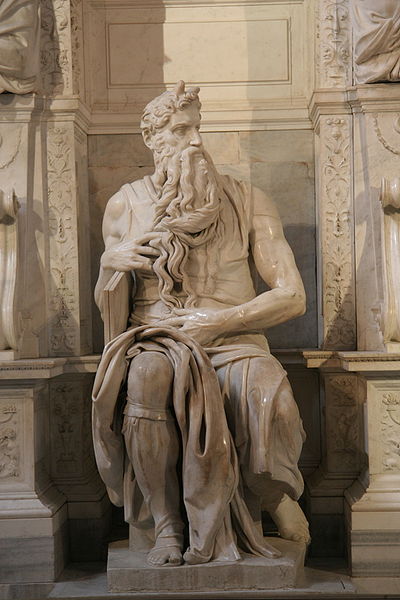
The other piece there left me a strong impression was the fresco by Paris Nogari - Freeing St Peter From Prison. It had marvelous dynamic composition, full of light and dark contrast and the ensuring mystique. This, naturally, paled comparing to the more famous one in the Vatican by Raphael, which had an additional otherworldly nightmarish feelings. But this lack of that particular weight did not rob the beauty of this minor masterpiece and the poignancy of seeing it in the church which also contained the relic of those chains. Particularly interesting were the expressions and gestures of those guards in the foreground, while the Raphael's piece had clearly focus on the central characters - the Angel and St Peter.
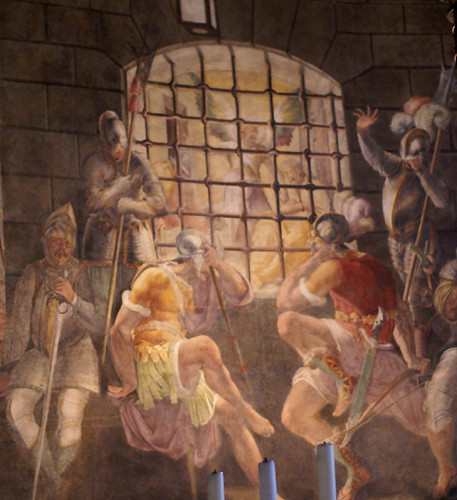
My Favorite Museum Collection Series
>> My Favorite Museum Collection Series 15: My Favorite Artworks at the Galleria dell'Accademia Firenze
<< My Favorite Museum Collection Series 13: My Favorite Artworks at Basilica Sancti Petri (Papal Basilica of Saint Peter)
For the indisputable artistic masterpiece, there was Michelangelo Buonarroti's marble sculpture Moses, the centerpiece of the unfinished tomb design for Pope Julius II, commissioned in 1505, depicting the Biblical character Moses, seated, with two templates under right arm, looking sharply towards afar, with horns on his head, based on a description in the Vulgate, the Latin translation of the Bible used at that time.
The character was alert, intelligent, and sinuous. An utterly unforgettable image. Despite the fact that Michelangelo didn't finish his whole design, this finished Moses was finished in every details and though I regretted that I couldn't see the whole project in its entirety, I could not think of any improvement of this monumental statue. Mountain like immobile, this Moses was a rich mine of wisdom and strength.

The other piece there left me a strong impression was the fresco by Paris Nogari - Freeing St Peter From Prison. It had marvelous dynamic composition, full of light and dark contrast and the ensuring mystique. This, naturally, paled comparing to the more famous one in the Vatican by Raphael, which had an additional otherworldly nightmarish feelings. But this lack of that particular weight did not rob the beauty of this minor masterpiece and the poignancy of seeing it in the church which also contained the relic of those chains. Particularly interesting were the expressions and gestures of those guards in the foreground, while the Raphael's piece had clearly focus on the central characters - the Angel and St Peter.

My Favorite Museum Collection Series
>> My Favorite Museum Collection Series 15: My Favorite Artworks at the Galleria dell'Accademia Firenze
<< My Favorite Museum Collection Series 13: My Favorite Artworks at Basilica Sancti Petri (Papal Basilica of Saint Peter)
Sunday, February 26, 2012
Friday, February 24, 2012
My Favorite Artworks at Basilica Sancti Petri (Papal Basilica of Saint Peter)
After some internal debate, I decided to include some major cathedrals I've visited in this My Favorite Museum Collection Series, though they usually don't hold as many important and/or iconic artworks in history, they still have much artistic values, and some boast very important works, such as the Pietà by Michelangelo Buonarroti in Basilica Sancti Petri (Papal Basilica of Saint Peter).
The image here is not an overwrought melodramatic gesture, rather a sad resignation. The very young Mary lowering her covered head, as if nodding to the command higher up. Her face was sweet, delicate and not a day older than the Annunciation. The body of Jesus was pathetic yet elegant, devoid of the insistent signs of mutilation so rampant in the medieval time. The interaction between the Virgin Mary and Jesus was tender, intimate and also theatrical. Mary, holding Jesus on her lap, as if presenting Jesus as offering for the world and to the world. This was a completely humanistic approach and it was a truly Renaissance product, yet its pyramidal composition was an obvious connection to the classical period, so was the restraint. The sculpturing of this marble statue was truly masterly - facial expressions true, body molding correct and draperies wonderfully realistic. This is a drama of sublimity.
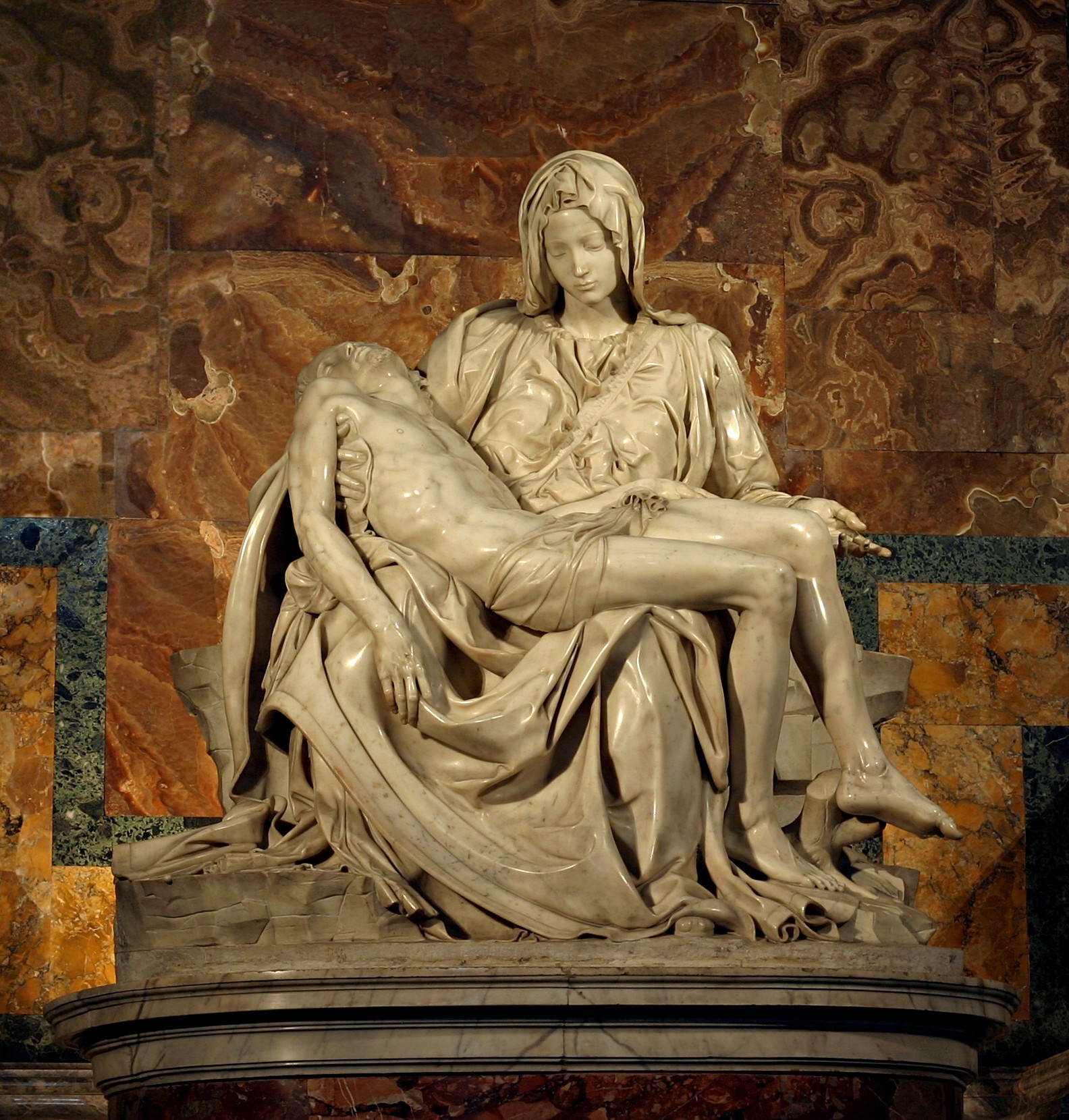
Michelangelo's Pietà
Source: Wikipedia, Author
Stanislav Traykov
There were many wonderful statues in countless niches in the basilica but none commanded attention as the baldacchino designed by the great sculptor Gian Lorenzo Bernini.

The altar with Bernini's baldacchino
Author Ricardo André Frantz (User:Tetraktys)
A baldachin, or baldaquin is a canopy of state over an altar or throne. Bernini's baldacchino was massive and imposing. The elaborate twisted pillars and the crown of it were of black and gold colors - rich, deep and sumptuous, in perfect harmony of the earthly splendor the Catholic church had adopted, which naturally would have caused awe and inevitably, feeling of great excess.
However, I'm not here to evaluate the social impact of this piece - rather, I see it as a masterpiece of decorative or architectural art.
It achieved its goal to inspire and awe perfectly. Its imposing size ensured that it would not be lost in the cavernous apse of Saint Peter's, rather, it became the centerpiece of it.
In great contrast to the smooth and economic surface of Michelangelo's Pietà, with great classical restraint, here its shapes and details were ever-more elaborate, full of endless variations, full of grace notes.
If Pietà invoked the music of Haydn, then this baldacchino invoked the music of Bellini or even Rossini. This is an artwork created by a virtuosic artist to celebrate a flamboyant era. The pillars of Baroque.
My Favorite Museum Collection Series
>> My Favorite Museum Collection Series 14: My Favorite Artworks in San Pietro in Vincoli (Saint Peter in Chains), Roma
<< My Favorite Museum Collection Series 12: My Favorite Sculptures at Museo Nazionale Romano, Roma
The image here is not an overwrought melodramatic gesture, rather a sad resignation. The very young Mary lowering her covered head, as if nodding to the command higher up. Her face was sweet, delicate and not a day older than the Annunciation. The body of Jesus was pathetic yet elegant, devoid of the insistent signs of mutilation so rampant in the medieval time. The interaction between the Virgin Mary and Jesus was tender, intimate and also theatrical. Mary, holding Jesus on her lap, as if presenting Jesus as offering for the world and to the world. This was a completely humanistic approach and it was a truly Renaissance product, yet its pyramidal composition was an obvious connection to the classical period, so was the restraint. The sculpturing of this marble statue was truly masterly - facial expressions true, body molding correct and draperies wonderfully realistic. This is a drama of sublimity.

Michelangelo's Pietà
Source: Wikipedia, Author
Stanislav Traykov
There were many wonderful statues in countless niches in the basilica but none commanded attention as the baldacchino designed by the great sculptor Gian Lorenzo Bernini.

The altar with Bernini's baldacchino
Author Ricardo André Frantz (User:Tetraktys)
A baldachin, or baldaquin is a canopy of state over an altar or throne. Bernini's baldacchino was massive and imposing. The elaborate twisted pillars and the crown of it were of black and gold colors - rich, deep and sumptuous, in perfect harmony of the earthly splendor the Catholic church had adopted, which naturally would have caused awe and inevitably, feeling of great excess.
However, I'm not here to evaluate the social impact of this piece - rather, I see it as a masterpiece of decorative or architectural art.
It achieved its goal to inspire and awe perfectly. Its imposing size ensured that it would not be lost in the cavernous apse of Saint Peter's, rather, it became the centerpiece of it.
In great contrast to the smooth and economic surface of Michelangelo's Pietà, with great classical restraint, here its shapes and details were ever-more elaborate, full of endless variations, full of grace notes.
If Pietà invoked the music of Haydn, then this baldacchino invoked the music of Bellini or even Rossini. This is an artwork created by a virtuosic artist to celebrate a flamboyant era. The pillars of Baroque.
My Favorite Museum Collection Series
>> My Favorite Museum Collection Series 14: My Favorite Artworks in San Pietro in Vincoli (Saint Peter in Chains), Roma
<< My Favorite Museum Collection Series 12: My Favorite Sculptures at Museo Nazionale Romano, Roma
Thursday, February 23, 2012
My Favorite Sculptures at Museo Nazionale Romano, Roma
The last museum I visited in Roma is Museo Nazionale Romano (Roman National Museum), which hosted an array of wonderful, even spectacular sculptures, including a version of a marble Discobolus (Disc Thrower), which is as iconic as Leonardo's Mona Lisa and Venus de Milo. However, despite my love for this famous image, I found this particular version of Discobolus, discovered in 1906 in the ruins of a Roman villa at Tor Paterno in the former royal estate of Castel Porziano, a bit still and plastic. It was heroic and beautiful for sure, but somewhat meaningless.
Instead, my favorites were two sculptures with understated grandeur, relative static poses belied the hidden tension.
The first was a marble statue of the Roman emperor, August as Pontifex Maximus. It was a full length sculpture, capturing the emperor, in flowing robe, walking quietly, as if weighing something of considerable importance. It's a fleeting moment, unguarded, without officious pomposity. A high-born nobleman for sure, but also intensely human. Pensive, and a bit sad.
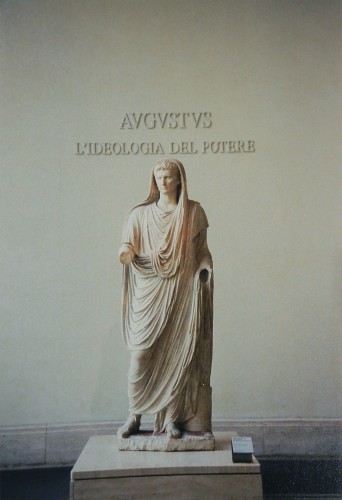
August as Pontifex Maximus, Palazzo Massimo alle Terme (Museo Nazionale Romano), Rome, Italy
However, that sadness would be eclipsed easily by the grand tragedy of the Dying Niobid, another marble sculpture, capturing one of the queen Niobe's fourteen children being shot to death by the vengeful arrows of the slighted Apollo and Artemis, when Niobe boasted that she had much greater number of children than those of Leto, Mother of Apollo and Artemis.
The Dying Niobid, fleeing, was shot on her back, faltered to be on her knee, bent backwards, both hands reached to the killing tool on her back. Her frontal torso and one leg exposed, revealing the beauty and the vulnerability of this tragic figure. Her face was peaceful, almost like asleep, without obvious pain, though she did have a questioning look upon closer inspection. Even her pose, though unbalanced, was not in painful twist. The sculptor did not want to shock the viewer, rather, he wanted to present this moment in restrained dignity. The more peaceful she seemed, the greater the sense of tragedy.
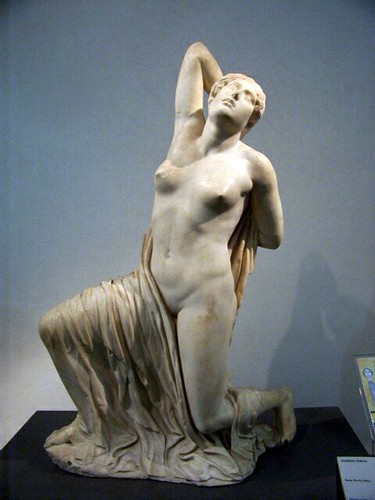
Dying Niobid, Palazzo Massimo, Museo Nazionale Romano, Rome
Source: diffendale
My Favorite Museum Collection Series
>> My Favorite Museum Collection Series 13: My Favorite Artworks at Basilica Sancti Petri (Papal Basilica of Saint Peter)
<< My Favorite Museum Collection Series 11: My Favorite Artworks at Galleria Borghese, Rome
Instead, my favorites were two sculptures with understated grandeur, relative static poses belied the hidden tension.
The first was a marble statue of the Roman emperor, August as Pontifex Maximus. It was a full length sculpture, capturing the emperor, in flowing robe, walking quietly, as if weighing something of considerable importance. It's a fleeting moment, unguarded, without officious pomposity. A high-born nobleman for sure, but also intensely human. Pensive, and a bit sad.

August as Pontifex Maximus, Palazzo Massimo alle Terme (Museo Nazionale Romano), Rome, Italy
However, that sadness would be eclipsed easily by the grand tragedy of the Dying Niobid, another marble sculpture, capturing one of the queen Niobe's fourteen children being shot to death by the vengeful arrows of the slighted Apollo and Artemis, when Niobe boasted that she had much greater number of children than those of Leto, Mother of Apollo and Artemis.
The Dying Niobid, fleeing, was shot on her back, faltered to be on her knee, bent backwards, both hands reached to the killing tool on her back. Her frontal torso and one leg exposed, revealing the beauty and the vulnerability of this tragic figure. Her face was peaceful, almost like asleep, without obvious pain, though she did have a questioning look upon closer inspection. Even her pose, though unbalanced, was not in painful twist. The sculptor did not want to shock the viewer, rather, he wanted to present this moment in restrained dignity. The more peaceful she seemed, the greater the sense of tragedy.

Dying Niobid, Palazzo Massimo, Museo Nazionale Romano, Rome
Source: diffendale
My Favorite Museum Collection Series
>> My Favorite Museum Collection Series 13: My Favorite Artworks at Basilica Sancti Petri (Papal Basilica of Saint Peter)
<< My Favorite Museum Collection Series 11: My Favorite Artworks at Galleria Borghese, Rome
Wednesday, February 22, 2012
New Items on Zazzle - Pillows, Napkins, iPad Sleeves and Pet Bowls
Recently, Zazzle added some exciting new items, such as pillows, napkins, pet clothes and pet bowls, etc.
I designed several Throw Pillows, utilizing my artworks and photographs. I also designed some cloth napkins and even a cat bowl with my childhood drawing of animals:
![Pillow - Oil Painting]()
Pillow - Oil Painting "White Dress with Birds" by MatthewFelixSun
Browse other pillow designs on Zazzle.
I designed several Throw Pillows, utilizing my artworks and photographs. I also designed some cloth napkins and even a cat bowl with my childhood drawing of animals:
Pillow - Oil Painting "White Dress with Birds" by MatthewFelixSun
Browse other pillow designs on Zazzle.
Labels:
Cat's Bowl,
Design,
Drawing,
Merchandise,
Napkin,
Oil Painting,
Pillow,
Zazzle
Tuesday, February 21, 2012
The Eyes of Electra - A New Drawing
Currently, I'm experimenting spatial relationship and geometric patterns in a series of Greek Mythology paintings, including themes on Helen, Paris, Orestes, Electra and Oedipus.
While making the time-consuming oil paintings, I made some drawing studies in various finished degrees. Below is the one for Electra - The Eyes of Electra. I image that her bloodshot eyes are lurking behind every corner of the dark, cold and unfriendly palace of Mycenae, Greece, and plotting the death of her vengeful mother and her lover who had murdered her father.

This drawing does not have the nightmarish feel my oil painting has but has a certain clarity the painting lacks. A reasonable compromise, I think.
Tag: Greek Abstract
While making the time-consuming oil paintings, I made some drawing studies in various finished degrees. Below is the one for Electra - The Eyes of Electra. I image that her bloodshot eyes are lurking behind every corner of the dark, cold and unfriendly palace of Mycenae, Greece, and plotting the death of her vengeful mother and her lover who had murdered her father.

This drawing does not have the nightmarish feel my oil painting has but has a certain clarity the painting lacks. A reasonable compromise, I think.
Tag: Greek Abstract
Labels:
Drawing,
Electra,
Greek Abstract,
Greek Mythology
Monday, February 20, 2012
Through Friendly Lens
 My friends stayed in my studio/guest apartment/office for several days and I was extremely happy to have the opportunity to clean up my messy studio, whose cleaning up had been long over-due.
My friends stayed in my studio/guest apartment/office for several days and I was extremely happy to have the opportunity to clean up my messy studio, whose cleaning up had been long over-due.Though the floor had been cleared away, the clutter of my walls, "gallery" style à la Palazzo Pitti, Florence, Italy (not the richness, but the tightness), was not touched upon during the preparation for my friends' stay.
I worried a bit that my mostly moody and dark paintings might be too overwhelming and too suffocating, in the crazy tight formation but my friends were undaunted.
Not only they weren't depressed by my gloomy works in a dark room, they managed to see light, peeping through the curtained windows and from behind the canvases right in front of the windows. The photographs they took definitely threw new light on my works and it is very interesting thing to see them through that friendly lens:
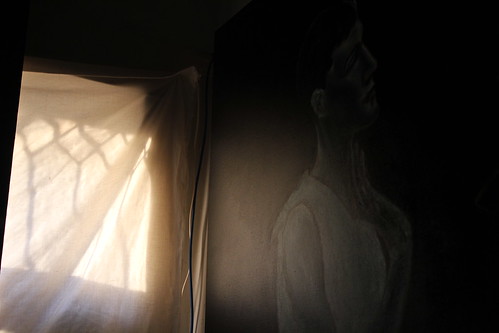

The originals, without the special lighting treatment are as below:
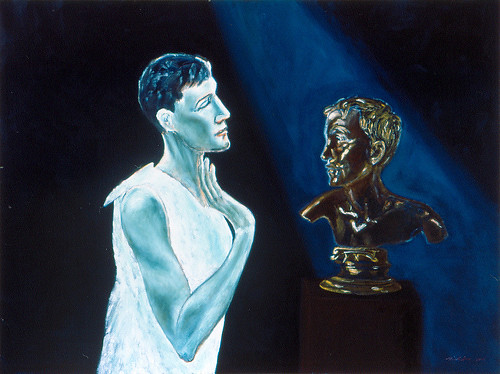
Encounter
Oil on Canvas
36" x 48"
Completed in 2001
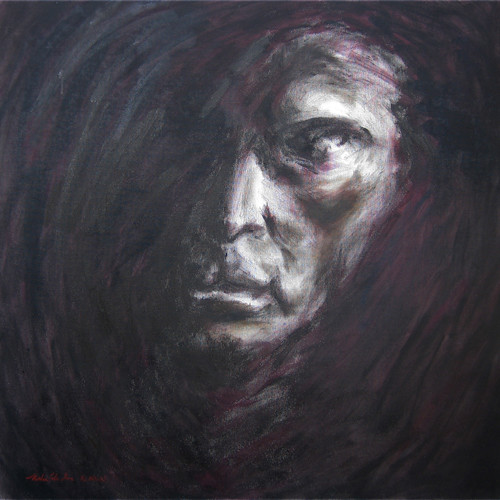
Pierce
Oil on Canvas
24" x 24"
Completed in 2011
Labels:
Display,
Paintings,
Palace,
Palazzo Pitti,
Pitti Palace
Saturday, February 18, 2012
My Favorite Artworks at Galleria Borghese, Rome
After the miracle of the Musei Vaticani (Vatican Museums), it might be tempting to say that I was saturated and couldn't take in any. But my greediness knew no bound, therefore, my pilgrimage continued, in the eternal city itself.
The other major art museum in Rome, besides the Vatican and the Musei Capitolini, is Galleria Borghese - the Borghese Gallery, housed in the former Villa Borghese Pinciana. "The Galleria Borghese houses a substantial part of the Borghese collection of paintings, sculpture and antiquities, begun by Cardinal Scipione Borghese, the nephew of Pope Paul V (reign 1605–1621)." [Wikipedia]
I remembered that during my visit to Roma, in late September, it was very still quite hot and I was very grateful to be inside the cool villa after long trek in the endless garden ground. The museum's arrangement was like that in someone's own home - a supremely rich person's home. I saw the art collections as the residents or guests would have seen, only need to remind myself that they ought not to be touched.
The scale of the villa, though big, was not as big as a palace, therefore deeply deceptive. I was constantly amazed at how many treasures it had held. It had a hugely important sculpture collections and some very important paintings. Flipping through the materials I collected and browse online, I zoom in for these two my favorites:

Apollo and Daphne Carrara's marble cm. 243 | Gian Lorenzo Bernini
This tall marble sculpture by the great sculpture Gian Lorenzo Bernini, was a marvel, vividly captured the moment Daphne, fleeing from the passion of Apollo, transformed into a laurel tree. Look at how the barks started to encase her lithe body and how her flowing hair and the tips of her hands were turning into leafy branches, therefore the obvious characteristics of Baroque epoch.
The official website of the Galleria provided further details on this masterpiece: "This life-size marble sculpture, begun by Bernini at the age of twenty-four and executed between 1622 and 1625, has always been housed in the same villa, but originally stood on a lower and narrower base set against the wall near the stairs. Consequently anyone entering the room first saw Apollo from behind, then the fleeing nymph appeared in the process of metamorphosis: bark covers most of her body, but according to Ovid's lines, Apollo's hand can still feel her heart beating beneath it. In 1785, when Marcantonio IV Borghese decided to place the work in the centre of the room, Vincenzo Pacetti designed the present base by using the original pieces, adding plaster to the plinth and another cartouche bearing the Borghese eagle, sculpted by Lorenzo Cardelli."
The second piece of my favorite in this Gelleria is an enigmatic painting by the great Titian (Tiziano), Sacred and Profane Love:

Sacred and Profane Love (1514 ca.) oil on canvas cm. 118x279 | Titian
This painting, made when Titian was about twenty-five to celebrate the marriage of the Venetian Nicolò Aurelio (coat of arms on the sarcophagus) and Laura Bagarotto in 1514, was actually a celebration of beauty of perfection and the chaste and stern woman in white was the bride herself, accompanied by Cupid and Venus, in her most alluring pose and attire. The strong contrast of these two evocative and provocative figures, the wonderful Arcadian landscape, and the playful putto, constituted an enchanting lyrical poetry.
According to the Galleria's description, the current allegorical title "is the result of a late 18th-century interpretation of the painting, which gives a moralistic reading of the nude figure, whereas the artist intended this to be an exaltation of both earthly and heavenly love. Titian's Sacred and Profane Love has virtually become the symbol of the Borghese Gallery itself."
My Favorite Museum Collection Series
>> My Favorite Museum Collection Series 12: My Favorite Sculptures at Museo Nazionale Romano, Roma
<< My Favorite Museum Collection Series 10: My Favorite Art Collections at Musei Vaticani (Vatican Museums)
The other major art museum in Rome, besides the Vatican and the Musei Capitolini, is Galleria Borghese - the Borghese Gallery, housed in the former Villa Borghese Pinciana. "The Galleria Borghese houses a substantial part of the Borghese collection of paintings, sculpture and antiquities, begun by Cardinal Scipione Borghese, the nephew of Pope Paul V (reign 1605–1621)." [Wikipedia]
I remembered that during my visit to Roma, in late September, it was very still quite hot and I was very grateful to be inside the cool villa after long trek in the endless garden ground. The museum's arrangement was like that in someone's own home - a supremely rich person's home. I saw the art collections as the residents or guests would have seen, only need to remind myself that they ought not to be touched.
The scale of the villa, though big, was not as big as a palace, therefore deeply deceptive. I was constantly amazed at how many treasures it had held. It had a hugely important sculpture collections and some very important paintings. Flipping through the materials I collected and browse online, I zoom in for these two my favorites:

Apollo and Daphne Carrara's marble cm. 243 | Gian Lorenzo Bernini
This tall marble sculpture by the great sculpture Gian Lorenzo Bernini, was a marvel, vividly captured the moment Daphne, fleeing from the passion of Apollo, transformed into a laurel tree. Look at how the barks started to encase her lithe body and how her flowing hair and the tips of her hands were turning into leafy branches, therefore the obvious characteristics of Baroque epoch.
The official website of the Galleria provided further details on this masterpiece: "This life-size marble sculpture, begun by Bernini at the age of twenty-four and executed between 1622 and 1625, has always been housed in the same villa, but originally stood on a lower and narrower base set against the wall near the stairs. Consequently anyone entering the room first saw Apollo from behind, then the fleeing nymph appeared in the process of metamorphosis: bark covers most of her body, but according to Ovid's lines, Apollo's hand can still feel her heart beating beneath it. In 1785, when Marcantonio IV Borghese decided to place the work in the centre of the room, Vincenzo Pacetti designed the present base by using the original pieces, adding plaster to the plinth and another cartouche bearing the Borghese eagle, sculpted by Lorenzo Cardelli."
The second piece of my favorite in this Gelleria is an enigmatic painting by the great Titian (Tiziano), Sacred and Profane Love:

Sacred and Profane Love (1514 ca.) oil on canvas cm. 118x279 | Titian
This painting, made when Titian was about twenty-five to celebrate the marriage of the Venetian Nicolò Aurelio (coat of arms on the sarcophagus) and Laura Bagarotto in 1514, was actually a celebration of beauty of perfection and the chaste and stern woman in white was the bride herself, accompanied by Cupid and Venus, in her most alluring pose and attire. The strong contrast of these two evocative and provocative figures, the wonderful Arcadian landscape, and the playful putto, constituted an enchanting lyrical poetry.
According to the Galleria's description, the current allegorical title "is the result of a late 18th-century interpretation of the painting, which gives a moralistic reading of the nude figure, whereas the artist intended this to be an exaltation of both earthly and heavenly love. Titian's Sacred and Profane Love has virtually become the symbol of the Borghese Gallery itself."
My Favorite Museum Collection Series
>> My Favorite Museum Collection Series 12: My Favorite Sculptures at Museo Nazionale Romano, Roma
<< My Favorite Museum Collection Series 10: My Favorite Art Collections at Musei Vaticani (Vatican Museums)
Thursday, February 16, 2012
Meet Agnes (Agnieszka) the Elephant
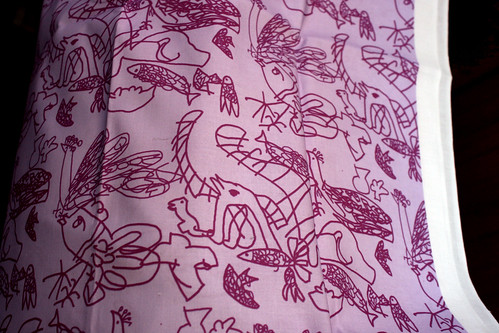 The multi-talented Quinn not only designed a whimsical fabric pattern with some quite strange childhood drawings of mine, she also made a stuffed elephant for me with the fabric she purchased from Spoon Flower online shop.
The multi-talented Quinn not only designed a whimsical fabric pattern with some quite strange childhood drawings of mine, she also made a stuffed elephant for me with the fabric she purchased from Spoon Flower online shop. She presented me the elephant last weekend during her visit. The elephant was very cute - big head, giant ears and tiny tail and best of all, a pair of stunned eyes. I named her Agnes (Agnieszka). The reason behind this was that during our very engaging conversation, I learned from her, a marvelous linguist amongst many other identities she assumes, that Agnes was a name wildly popular in Poland, and that made a great impression on me and I thought that Agnieszka was a fitting name for my cuddly new friend:
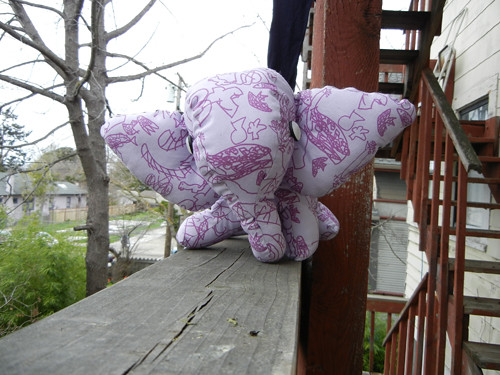
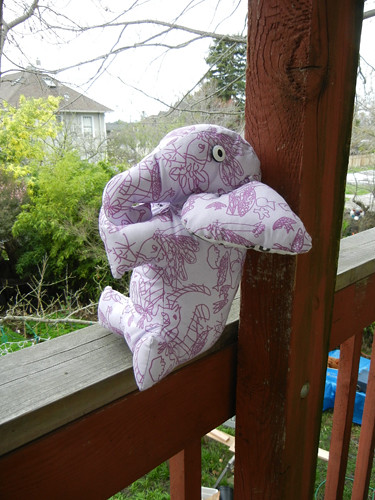


However, "my" cat seemed disagree. Since I hadn't decided on a permanent home for Agnes yet, I placed Agnes on a pile of dark clothes I gathered for the Goodwill in my bedroom, which door was generally closed to keep my cat out - she liked to hide inside our rather large closet which has no door to keep her out and it is too difficult and agonizing to locate her, so I was forced to confine her space to our living room, kitchen, bathroom and the back deck.
Anyway, yesterday, I took some recycling materials downstairs after I got back home from work and left my bedroom door open momentarily. When I came back, I saw that Agnes was lying on the floor in the middle of the bedroom. I picked her up and tried to put her back to her temporary spot, then realized that her spot had been usurped by no other than the cat! The cat cunningly blended in with my dark clothes - you can see that her is a sort of tuxedo cat. I'd better find a good place for my Agnieszka, preferably high up, so my jealous cat would not pounce on her again.
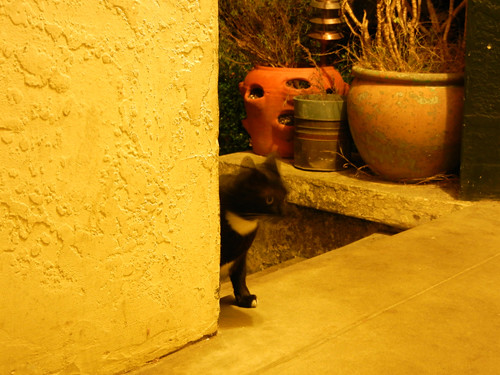

Tuesday, February 14, 2012
My Favorite Art Collections at Musei Vaticani (Vatican Museums)

Photo by DAVID ILIFF. License: CC-BY-SA 3.0"
My first European trip consisted the visits to Italy and France in the jubilee year 2000. We arrived in Rome and the first museums we visited were the Musei Vaticani (Vatican Museums). I definitely started from the top.
There were too many treasures to mention there, including the Sistine Chapel with Michelangelo's greatest masterpiece - the Creation and the Last Judgement. Yet, two sculptures edged them out in my book. The first is the so-called Belvedere Apollo. To me, this classical sculpture was the embodiment of perfection. This young god, with his beautifully proportioned limbs, wonderfully shaped torso, and finely chiseled face and curly locks, displayed himself without hesitation and discomfort. This sculpture is the ode to an era which valued human and humanity the most and rightly so it became the symbol of the ideal. Only Michelangelo's David in Florence, Italy, came close to the radiant humanity, confidence and beauty.

Belvedere Apollo (2nd century Roman copy of 4th century BC bronze sculpture of artist from Attica) (Cortile ottagonale del Belvedere, Octagonal Court of Belvedere)
Source: Cambridge 2000 Gallery
The second choice of mine is the opposite in mood and movement. It was a group sculpture -Trojan priest Laocoön and his sons Antiphantes and Thymbraeus being strangled by sea serpents, as depicted by Homer in Iliad. This much-admired Laocoön and his Sons has been attributed by Pliny the Elder to the Rhodian sculptors Agesander, Athenodoros, and Polydorus.
Here, they were in fear, agony and terror. They struggled and fought, helplessly. Yet, they were not an entangled mess. They were clearly delineated, beautifully illustrated and as if even horrible death could not destroy the humanness of these three, however pitiful they were.
This sculpture is full of movements and dynamic poses. Highly dramatic and effective yet never betrayed the economy of classics. An absolute masterpiece.
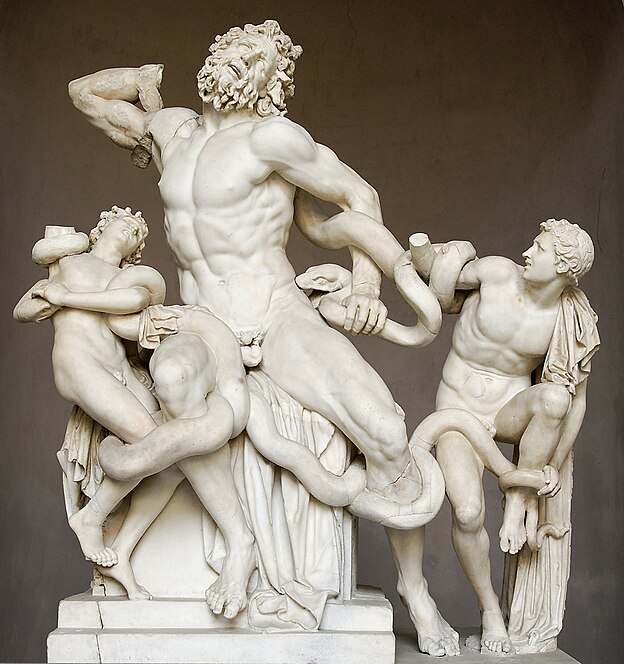
U.S. public domain, source: Wikipedia
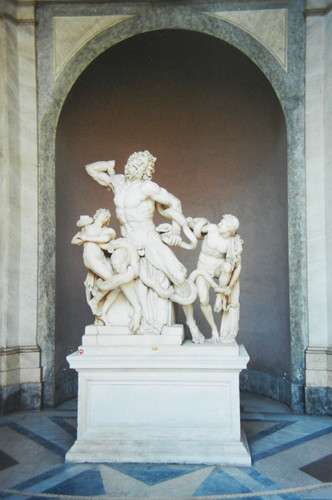
My Favorite Museum Collection Series
>> My Favorite Museum Collection Series 11: My Favorite Artworks at Galleria Borghese, Rome
<< My Favorite Museum Collection Series 9: My Favorite Paintings at National Gallery of Art, Washington DC
Monday, February 13, 2012
Review of "As Above, So Below" by Rudy Von B. Rucker
 As Above, So Below by Rudy Von B. Rucker
As Above, So Below by Rudy Von B. RuckerMy rating: 3 of 5 stars
Very fascinating fictional account of Pieter Bruegel the Elder's life. Several famous paintings by the master were cleverly employed to propel the plot. However, the stories got somewhat way too far-fetched. The author, obviously no artist, gave a pedestrian account of how inspirations and commissions came to Bruegel and the depictions of process of creations were less than inspired. The most serious flaw was the repetitive expositions (historical information best feed in through footnotes here) and the stiff dialogues. That said, it was a fascinating story about a fascinating artist in a most stirring time.
I remembered many paintings I saw in Kunsthistorisches Museum, Vienna and some in Rotterdam and I browsed a copy of a monograph on Bruegel and learned a scholarly account of those famous paintings and that made a complimentary study of this master. After you've read this novel, it would be great to read similar monograph to fully grasp his achievement and his time.
Related posts on Art · 文化 · Kunst:
- Devastating Novel "The Land of Green Plums" by Herta Müller
- Ashamed of Oneself - Reading Book "Never Let Me Go"
- Molotov's Magic Lantern: A Journey In Russian History by Rachel Polonsky and Some Journeys of My Own
- David Malouf's Ransom
- Banned Books in Mao's China
Saturday, February 11, 2012
My Favorite Paintings at National Gallery of Art, Washington DC
National Gallery of Art in Washington DC is the second major art museum I've visited, after the Metropolitan Museum in New York City.
It was long time ago and I had to admit that the museum didn't leave much an impression on me. Yet, dig into my memory and the official website from the Gallery, it was not hard to remember those two paintings made the most impressions on me.
My first pick is an oil painting, Ranuccio Farnese, by the incomparable master, Tiziano, or Titian.

Titian, Italian, c. 1490 - 1576
Ranuccio Farnese, 1542
oil on canvas
overall: 89.7 x 73.6 cm (35 5/16 x 29 in.) framed: 124.8 x 126.4 x 9.5 cm (49 1/8 x 49 3/4 x 3 3/4 in.)
This portrait of the delicate youth captured the first bloom of him wonderfully. The complexity of the expression on this precocious boy's face is beyond his age and one pains for him. Titian, a true master of Venetian school, excelled in his handling of the oil paints and his colors, particularly those on the doublet of the boy, simmered, and one wants to feel the silky surface of the fabric, revealing the master's signature technique of applying numerous layers of translucent oil glazes.
National Gallery stated that the painting was "commissioned as a gift for the boy's mother, this portrait of twelve-year-old Ranuccio was painted in Venice just after he had been made prior, or religious director, of San Giovanni dei Forlani, an important property belonging to the Knights of Malta. The grandson of Pope Paul III, Ranuccio was the youngest member of one of the wealthiest and most powerful families in Italy. He became cardinal of Santa Lucia in Sicily at the age of fifteen, and he was granted several bishoprics before his untimely death at the age of thirty-five."
My second favorite work there was another portrait, in the same melancholic vein. This portrait, by the Dutch painter Rogier van der Weyden, of the ethereal young lady was as delicate and beautiful as those by the more renown Botticelli. The artist created wonderful linear contours of the woman - her high-cheek-boned face, her gauzy headdress, her swan-like thin, long neck, her small waist and her delicate facial features, all contributed to the otherworldliness of this young lady.
More over, the colors Van der Weyden employed were sparse, austere, yet exceptionally beautiful. The large central area was in pale skin tone and creamy colors of the headdress, framed by rich black robe and deep greenish-blue flat background. Echoing a pale golden hair band on the top of the panel, a richly-accented red belt broke the dark areas of the robe and the background, and added some weight to the bottom of the panel, therefore gave the figure and the work more balance.

Rogier van der Weyden, Netherlandish, 1399/1400 - 1464
Portrait of a Lady, c. 1460 oil on panel
painted surface: 34 x 25.5 cm (13 3/8 x 10 1/16 in.) overall (panel): 37 x 27 cm (14 9/16 x 10 5/8 in.) framed: 60.9 x 53.3 x 11.4 cm (24 x 21 x 4 1/2 in.)
The National Gallery informs us that Rogier was among the greatest painters of northern Europe. His inventiveness and emotional intensity had great and lasting influence.
It also pointed out that the painting has "a severe balance of pattern and form -- notice the interlocking triangles in her veil and neckline -- creates a brittle, abstract elegance that is typical of Rogier's portraits. Details are reduced to geometric clarity, and the face is painted in a restrained, linear manner."
My Favorite Museum Collection Series
>> My Favorite Museum Collection Series 10: My Favorite Art Collections at Musei Vaticani (Vatican Museums)
<< My Favorite Museum Collection Series 8: My Favorite Collections at Musei Capitolini, Roma
It was long time ago and I had to admit that the museum didn't leave much an impression on me. Yet, dig into my memory and the official website from the Gallery, it was not hard to remember those two paintings made the most impressions on me.
My first pick is an oil painting, Ranuccio Farnese, by the incomparable master, Tiziano, or Titian.

Titian, Italian, c. 1490 - 1576
Ranuccio Farnese, 1542
oil on canvas
overall: 89.7 x 73.6 cm (35 5/16 x 29 in.) framed: 124.8 x 126.4 x 9.5 cm (49 1/8 x 49 3/4 x 3 3/4 in.)
This portrait of the delicate youth captured the first bloom of him wonderfully. The complexity of the expression on this precocious boy's face is beyond his age and one pains for him. Titian, a true master of Venetian school, excelled in his handling of the oil paints and his colors, particularly those on the doublet of the boy, simmered, and one wants to feel the silky surface of the fabric, revealing the master's signature technique of applying numerous layers of translucent oil glazes.
National Gallery stated that the painting was "commissioned as a gift for the boy's mother, this portrait of twelve-year-old Ranuccio was painted in Venice just after he had been made prior, or religious director, of San Giovanni dei Forlani, an important property belonging to the Knights of Malta. The grandson of Pope Paul III, Ranuccio was the youngest member of one of the wealthiest and most powerful families in Italy. He became cardinal of Santa Lucia in Sicily at the age of fifteen, and he was granted several bishoprics before his untimely death at the age of thirty-five."
My second favorite work there was another portrait, in the same melancholic vein. This portrait, by the Dutch painter Rogier van der Weyden, of the ethereal young lady was as delicate and beautiful as those by the more renown Botticelli. The artist created wonderful linear contours of the woman - her high-cheek-boned face, her gauzy headdress, her swan-like thin, long neck, her small waist and her delicate facial features, all contributed to the otherworldliness of this young lady.
More over, the colors Van der Weyden employed were sparse, austere, yet exceptionally beautiful. The large central area was in pale skin tone and creamy colors of the headdress, framed by rich black robe and deep greenish-blue flat background. Echoing a pale golden hair band on the top of the panel, a richly-accented red belt broke the dark areas of the robe and the background, and added some weight to the bottom of the panel, therefore gave the figure and the work more balance.

Rogier van der Weyden, Netherlandish, 1399/1400 - 1464
Portrait of a Lady, c. 1460 oil on panel
painted surface: 34 x 25.5 cm (13 3/8 x 10 1/16 in.) overall (panel): 37 x 27 cm (14 9/16 x 10 5/8 in.) framed: 60.9 x 53.3 x 11.4 cm (24 x 21 x 4 1/2 in.)
The National Gallery informs us that Rogier was among the greatest painters of northern Europe. His inventiveness and emotional intensity had great and lasting influence.
It also pointed out that the painting has "a severe balance of pattern and form -- notice the interlocking triangles in her veil and neckline -- creates a brittle, abstract elegance that is typical of Rogier's portraits. Details are reduced to geometric clarity, and the face is painted in a restrained, linear manner."
My Favorite Museum Collection Series
>> My Favorite Museum Collection Series 10: My Favorite Art Collections at Musei Vaticani (Vatican Museums)
<< My Favorite Museum Collection Series 8: My Favorite Collections at Musei Capitolini, Roma
Thursday, February 9, 2012
Onegin, Werther and Other Seminal (Yet Obscure) Works in World Literature
 |
| Roxana Constantinescu as Charlotte and James Valenti as Werther at the MN Opera. Photo by Michal Daniel. Source: Aisle Say Magazine |
Werther (pronounced ver-TAIR) was such a hit in Goethe's day that Massenet's 1892 operatic adaptation could be likened to the movie version of Harry Potter or Lord of the Rings. The original publication of the book inspired devoted readers to dress up as Werther, and a rash of copycat suicides led authorities to worry about "Werther Fever." The story, so deeply resonant in the minds of 18th- and 19th-century European readers and viewers, tells of young love kept apart by duty and tradition. In a nutshell: Werther – a brooding young man who modern audiences would call "emo" – sees Charlotte at a ball and falls madly and instantly in love with her. Charlotte, however, has promised her dying mother that she would marry Albert. Unable to cope with his heartbreak – sorry for the spoiler – Werther shoots himself.This is rather surprising that a caution of spoiler. Don't we all know of the basic storyline of Die Leiden des jungen Werthers (The Sorrow of the Young Werther) by Goethe? Don't we all know that Werther shot and killed himself in the seminar novel of the world literature? Is the spoiler alert really needed?
This reminded me a ballet performance of "Onegin" by Eifman Ballet I attended a few years ago, at Cal Performances in Berkeley, California. During a pivotal scene, the heroine Tatiana wrote love letter to the protagonist, Eugene Onegin. The innovative choreographer Boris Eifman kept the ballerina accompanied by the reading of the letter, in Alexandr Pushkin's original Russian poetry. The old gentleman sat next to me kindly whispered to me the English translations, unaware of the fact that I had been very familiar with the story and though I couldn't understand the reading verbally, I knew every nuances of the letter and the movement of the dancer.
Even when I was a child, in Mao's China, I knew of the stories of Eugene Onegin and the young Werther. I remember vividly the cover of the copy of Die Leiden des jungen Werthers (in Chinese translation, in traditional characters) my father kept on his bookshelf. Years later, I read both books in English translations and have seen various reincarnations of them - films, dances, operas, etc. They were so familiar to me that I often forget that despite the supremely importance of these two literature works, many people in the U.S. still have no idea what they are and what they are about.
 |
| Cover of the first edition, 1925 Source: wikipedia |
Labels:
Ballet,
Eugene Onegin,
F. Scott Fitzgerald,
Goethe,
Literature,
Opera,
Poetry,
Pushkin,
Werther
Tuesday, February 7, 2012
My Favorite Collections at Musei Capitolini, Roma
 |
| Source: Legion of Honor |
Medusa is a wonderful 1640s marble sculpture on loan from Musei Capitolini (Capitoline Museums), Rome. It is incredibly horrifying yet sensual. A masterpiece. Yet, when I visited Rome in 2000, other two sculptures in the courtyard of the museum impressed me more.
One is the Colossus of Constantine. Wikipedia described this work vividly: "The Colossus of Constantine was a colossal acrolithic statue of the late Roman emperor Constantine the Great (c. 280–337) that once occupied the west apse of the Basilica of Maxentius near the Forum Romanum in Rome. Portions of the Colossus now reside in the Courtyard of the Palazzo dei Conservatori of the Musei Capitolini, on the Capitoline Hill, above the west end of the Forum."
"The great head, arms and legs of the Colossus were carved from white marble, while the rest of the body consisted of a brick core and wooden framework, possibly covered with gilded bronze. (“Acrolithic” means “stone at the extremities”.) Judging by the size of the remaining pieces, the seated, enthroned figure would have been about 12 m (40 ft) high. The head is about 2 ½ m high and each foot is over 2 m long."
They are incredibly huge. Powerful. Stern. In humane. If anyone has any doubt of the grandiosity of the Roman Empire, these fragments would rid them once for all.


In the same grandiose scale, the marble sculpture Oceanus framed the plaza with his powerful body. Yet, this water god was nothing but menacing. He was a indulgent father figure, brought bounty to the people. Solid and comforting.
Besides the Olympian scales, this god also echoes the emperor in the somewhat stiff contour and pose, less polished and with less curvature, than that of Bernini's fine piece. More primitive. And that was precisely what made these two pieces most impressive.

1rst - 2nd century AD
Marble
cm 242
My Favorite Museum Collection Series
>> My Favorite Museum Collection Series 9: My Favorite Paintings at National Gallery of Art, Washington DC
<< My Favorite Museum Collection Series 7: An Exception - Another Favorite Work from De Young Museum, San Francisco
Sunday, February 5, 2012
An Exception - Another Favorite Work from De Young Museum, San Francisco
Despite the rule I made that I would only cite two pieces from each museum I've visited, I decided to cite a third from the De Young Museum, San Francisco.
The reason for this exception is that I just lost a dear friend, and it was only recently we visited that museum together. I am left with an indelible image of my friend in front of the piece I want to cite today. I will forever cherish the memory of her, from many times and places, including in front of that installation.

Installation: Hovor II, 2004, El Anatsui (b 1944), Woven aluminum bottle caps, copper wire, De Young Museum, San Francisco
This piece calls forth a certain social awareness, which mirrors my friend's lifelong dedication to the well-being of humanity and to social justice. My friend was like a solid oak tree, spreading her branches to reach out as far as she could, in her own saintly yet humble way, as committed as an oak’s deep roots. Those bottle caps in El Anatsui’s Hovor II are like green leaves of the wonderful oak tree, rustling, dancing and falling, making me sad and making me smile.
My Favorite Museum Collection Series
>> My Favorite Museum Collection Series 8: My Favorite Collections at Musei Capitolini, Roma
<< My Favorite Museum Collection Series 6: My Favorite Collections at The Cloisters, Metropolitan Museum of Art, New York
The reason for this exception is that I just lost a dear friend, and it was only recently we visited that museum together. I am left with an indelible image of my friend in front of the piece I want to cite today. I will forever cherish the memory of her, from many times and places, including in front of that installation.

Installation: Hovor II, 2004, El Anatsui (b 1944), Woven aluminum bottle caps, copper wire, De Young Museum, San Francisco
This piece calls forth a certain social awareness, which mirrors my friend's lifelong dedication to the well-being of humanity and to social justice. My friend was like a solid oak tree, spreading her branches to reach out as far as she could, in her own saintly yet humble way, as committed as an oak’s deep roots. Those bottle caps in El Anatsui’s Hovor II are like green leaves of the wonderful oak tree, rustling, dancing and falling, making me sad and making me smile.
My Favorite Museum Collection Series
>> My Favorite Museum Collection Series 8: My Favorite Collections at Musei Capitolini, Roma
<< My Favorite Museum Collection Series 6: My Favorite Collections at The Cloisters, Metropolitan Museum of Art, New York
Subscribe to:
Comments (Atom)











